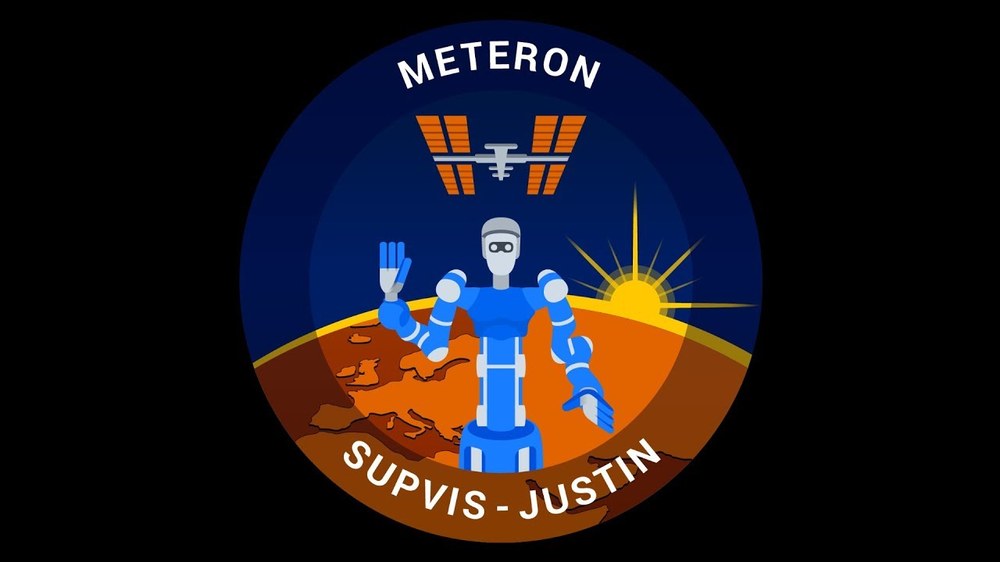So far and yet so near: Alexander Gerst controls robot on Earth
Alexander Gerst pauses. Smoke is rising from the satellite receiving system that he is in the process of building with the help of his robotic avatar on Mars. Now it is a matter of acting quickly and decisively, for the sake of human and machine alike. The simulation of an emergency is the most critical part of the latest telerobotics experiment at the German Aerospace Center (Deutsches Zentrum für Luft- und Raumfahrt; DLR), whereby an astronaut on board the International Space Station (ISS) uses a tablet to remotely control the humanoid robot Rollin' Justin in Oberpfaffenhofen. The last of three METERON SUPVIS Justin experiments took place on 17 August 2018 in the Mars Laboratory of the DLR Institute of Robotics and Mechatronics, with support successfully provided by the German ESA astronaut Alexander Gerst as part of his 'horizons' mission.
The innovative nature and special challenge of this experiment lay in the high degree of autonomy enjoyed by the astronaut and the extended scope for action by his robot colleague. Gerst not only had to master the most complex telerobotic tasks ever conducted in space, but also to react to unexpected situations.
"Intelligent robots will play an important role in the future of astronautical space travel, particularly on exploration missions. They can support the work of people in orbit and on Earth to explore difficult-to-access high-risk regions," says Hansjörg Dittus, DLR Executive Board Member for Space Research and Technology. "The technology and findings resulting from the METERON SUPVIS Justin experiment will also make it possible to develop an array of applications on Earth. This is particularly pertinent to fields that require reliable and safe cooperation and interaction between people and machines, such as assistance and care robotics or industrial construction and maintenance." As recently as May, the DLR Institute of Robotics and Mechatronics presented its SMiLE project, which is developing robots to provide care for the elderly and physically impaired.
A foundation for future space missions
Rollin' Justin was controlled intuitively, with Gerst using the tablet to determine which work steps would be carried out by the robot, without specifying exactly how they should be executed. The humanoid robot performs basic tasks informed by the context, and uses its artificial intelligence to make the necessary decisions. As part of the European Union's METERON (Multi-Purpose End-to-End Robotic Operation Network) range of experiments, robotics experts at DLR have further developed their telerobotics technologies and created realistic scenarios for planetary exploration. This has proven that robotic co-workers can provide valuable and sometimes even vital support for humans, and can be used for a wide range of exploratory, construction and maintenance tasks.
"Our aim is to demonstrate that robotic co-workers could be deployed on distant planets or the Moon. They could help us to create the first colony in space. The operating concepts and technology that we are continuously developing for this purpose should form the basis for robotic space missions in future," says Neal Lii, the project manager at the DLR Institute of Robotics and Mechatronics.
To ensure that the scenario was as realistic as possible, Alexander Gerst and Rollin' Justin were left on their own to carry out their task, largely without contact with the ground crew. Despite such constraints, the German ESA astronaut was able to interact intuitively with his robot colleague and succeeded in managing even the most complex tasks – from servicing a solar unit to constructing a receiving station. The highlight of the two-hour live experiment was the successful replacement of the station module, which suddenly burst into flames. The METERON SUPVIS Justin team was thus able to demonstrate that intelligent robots can support humans even in unexpected situations in remote locations, in much the same way that an on-site work colleague would.
About the missions
The German ESA astronaut Alexander Gerst embarked on his second long-term mission – 'horizons: Knowledge for Tomorrow' – to the Internationalen Raumstation ISS on 6 June 2018. By the time he returns to Earth in December 2018, Gerst will have worked on a total of 67 European experiments, 41 of which are German. These should contribute towards devising solutions to global societal challenges such as health, the environment and climate change, not to mention digitalisation, Industry 4.0, energy and future mobility.
The METERON SUPVIS Justin experiment is a collaborative enterprise between DLR and the European Space Agency (ESA). The ISS and the Columbus module serve as the ideal test environment for the use of new telerobotics technologies. Support was provided by the Columbus Control Center, part of the German Space Operations Center (GSOC) at DLR's site in Oberpfaffenhofen, near Munich. The Columbus Control Center is responsible for running the ISS Space Laboratory and has been working round the clock for 10 years. In total, around 80 GSOC employees are engaged in European research work on the ISS.
Replay of the experiment Livestream

METERON SUPVIS Justin experiment with Alexander Gerst
Your consent to the storage of data ('cookies') is required for the playback of this video on Youtube.com. You can view and change your current data storage settings at any time under privacy.

